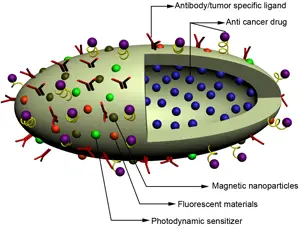In the movie, “Inner Space” (1987) actor Dennis Quaid was shrunk to microscopic size and entered the body of actor Martin Short with comical consequences. True to form what began was an exciting science fiction journey within the human body mixed with a few laughs and melodrama. What was once science fiction then can now be considered science fact.
While we still lack the technology of shrinking ourselves to microscopic levels and doing repair work to individual cells, researchers from the University of Cincinnati have developed a unique nano-structure using existent nano systems, that can not only can diagnose cancer, but can also act as a delivery system to repair cells at the same time. Nano carriers are nothing new, in fact those that have been developed before this were only designed to either diagnose or treat but not both. What the Cincinnati researchers have done can be considered a small quantum leap in what this kind of technology can do to diagnose and treat life threatening diseases.
Donglu Shi, professor of materials, science and engineering at UC’s College of Engineering and Applied Science said: “In this effort, we’re using existing basic nano systems, such as carbon nanotubes, graphene, iron oxides, silica, quantum dots and polymeric nano materials in order to create an all-in-one, multidimensional and stable nano carrier that will provide imaging, cell targeting, drug storage and intelligent, controlled drug release.”
Known technically as the Janus surface, the nano carrier features a double sided surface that can detect cancer cells and at the same time wrap anti-cancer medication along its porous interior.
What the nano carrier does is transport cancer-specific detection nanoparticles and biomarkers to a site within the body such as the prostate or breast. This allows for earlier diagnosis than what is currently possible with today’s tools. A fluorescent marker will attach in order to specifically illuminate cancer cells so that they are easier to locate and for determining treatment method whether surgery or drug delivery. Lastly, the nano carrier can precisely deliver the drugs to the cancer cells for efficient treatment with minimal side effects.
All of this information is contained in the research paper “Dual Surface Functionalized Janus Nanocomposites of PolystyreneFe304@Si02 for Simultaneous Tumor Cell Targeting and pH-Triggered Drug Release” that will be presented by the UC researchers at the annual Materials & Science Technology Conference in Montreal, Canada.
Effective with Fewer Side Effects
If this nano technology could be developed and someday become the main diagnostic option for cancer, it promises not just early diagnosis but a quicker and more accurate one at a more affordable cost than today’s existing diagnostic techniques. Moreover, when it comes to the treatment side of the equation, nano technology like the Janus nano carrier provides doctors with a delivery method that could provide an accurate payload of anti-cancer drugs without damage to nearby cells resulting in better dosage control. The effect would be a highly efficient drug delivery system that offers not just efficiency of delivery but lower dosage requirements for the patient.












